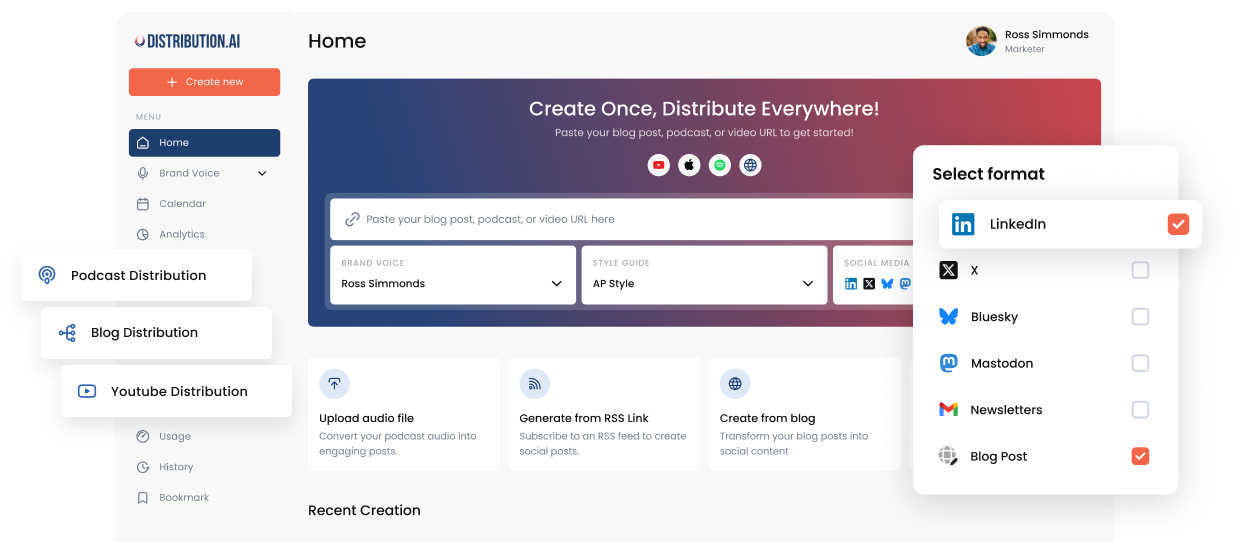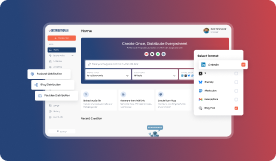Cracking the 2025 Facebook Algorithm: Proven Tactics for Brands
Learn how Facebook ranks content in 2025 and what you can do to make your posts stand out.
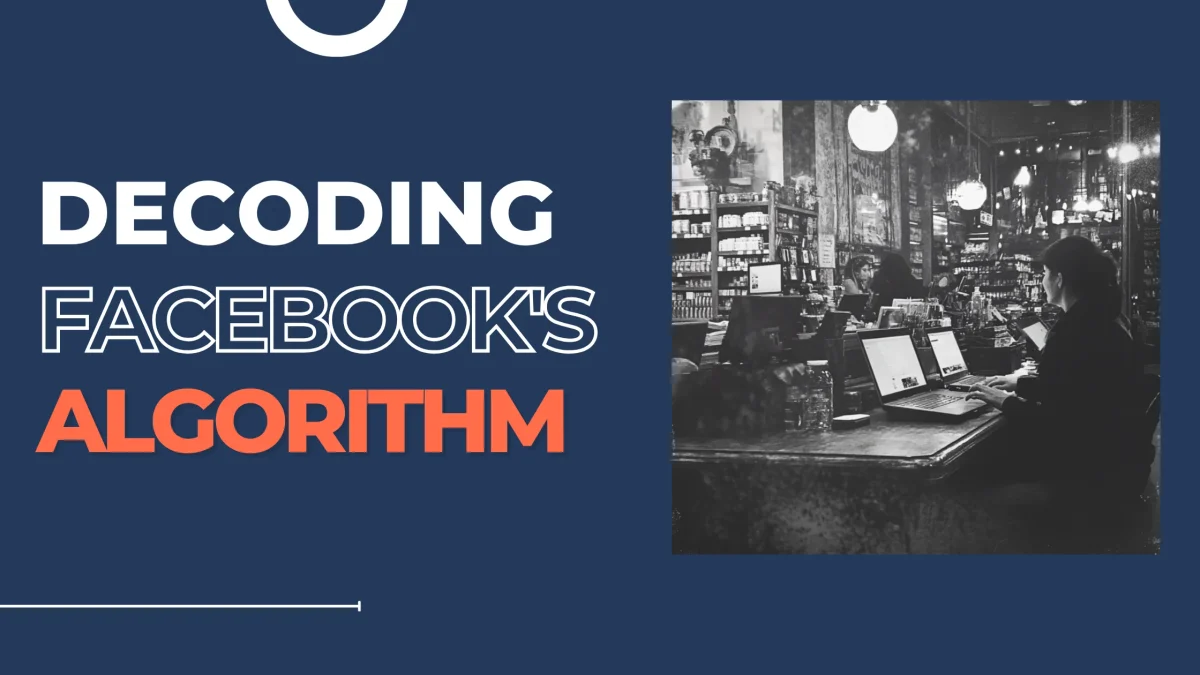
With over 3 billion Facebook users scrolling daily, the Facebook algorithm stands between your brand and a massive opportunity.
This ranking system controls which content lands in the user’s feed, how often your posts get seen, and whether you actually reach your target audience.
The rules have shifted dramatically in 2025, and brands ignoring these changes risk losing organic reach entirely.
This guide breaks down exactly how the Facebook algorithm works, which ranking signals drive visibility, and the proven tactics that help your content rise above the noise on the world’s largest social media platform.
How Does the Facebook Algorithm Work?
The Facebook algorithm analyzes thousands of ranking signals to decide what content each of the platform’s billions of Facebook users sees in their feed.
The Facebook algorithm works through 4 key components:
- Inventory (all available posts),
- Signals (data points like who posted it and when),
- Predictions (likelihood you’ll engage).
- Relevance (content with higher relevance scores gets priority)
Facebook calls this framework “inventory signals predictions relevance,” and it’s how the platform ranks content for every single user.
How the Facebook Algorithm Is Changing in 2025
The Facebook algorithm is a constantly evolving system that has been refined throughout 2025 to change how Facebook users discover content.
1. AI and Machine Learning Dominate
Machine learning now drives everything.
Facebook runs over 100 prediction models that analyze user behavior, past behavior, and interaction patterns to determine what each user will find valuable.
The system analyzes dwell time, search history, and numerous ranking signals to personalize each user’s feed.
What one person sees differs completely from what another sees, even when following the same Facebook pages.
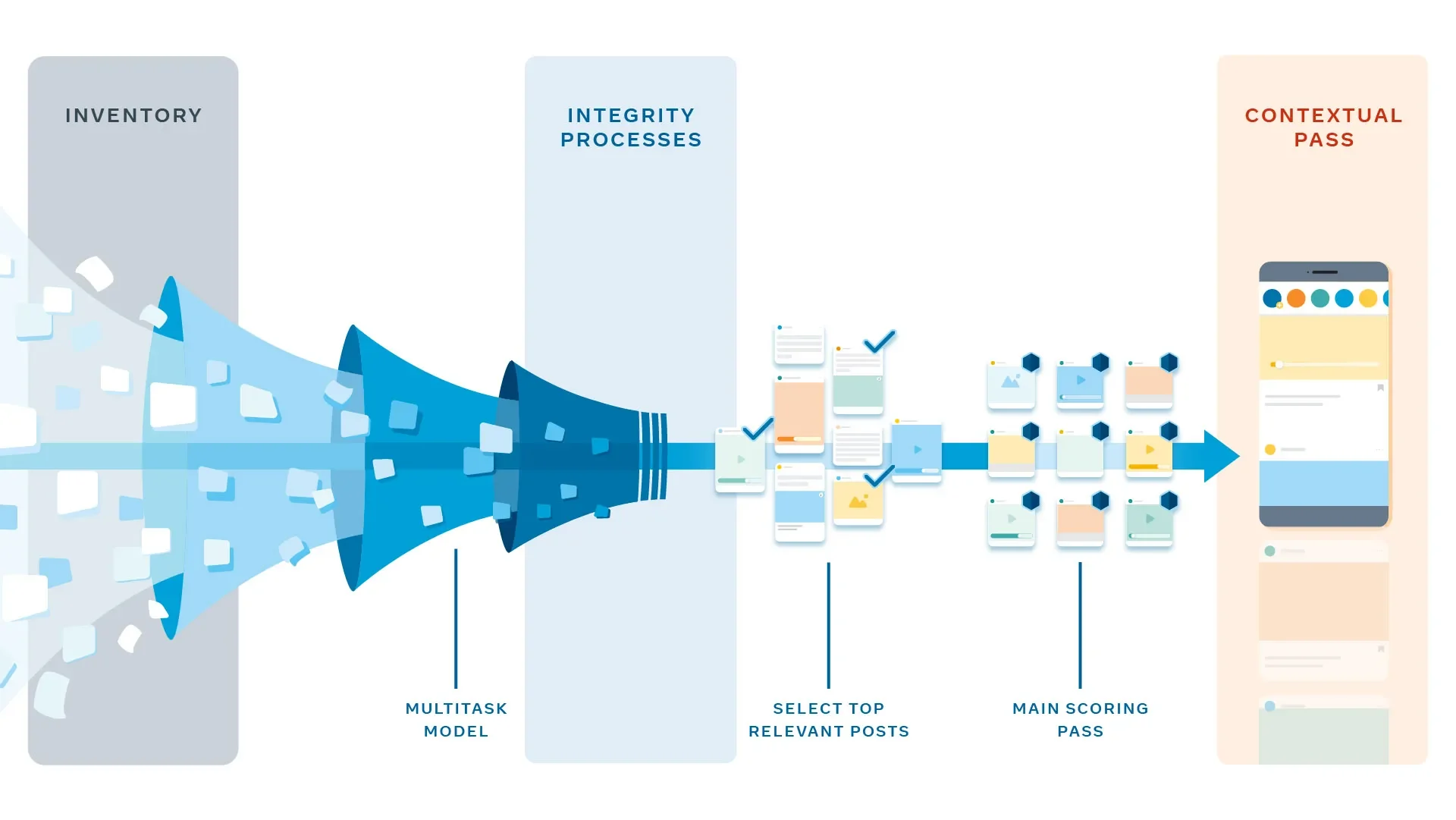
2. Authenticity Beats Everything
Facebook prioritizes content that sparks meaningful interactions, such as thoughtful comments and shares, over passive likes.
Engagement bait gets suppressed hard. The algorithm distinguishes honest conversations from manufactured engagement.
Also, interactive formats dominate. Facebook reels, polls, and live videos outperform static posts because they keep users actively engaged.
The longer someone interacts with your content, the stronger the value signal.
3. The Relevance Score
Every post gets a relevance score determining its feed placement.
The Facebook algorithm uses inventory signals, prediction relevance (all available posts), hundreds of data points, engagement predictions, and user-specific relevance calculations.
Key ranking factors include:
- Video content and vertical video outrank text-based posts
- A consistent posting schedule signals reliability
- Facebook pages with a quality content history start ahead
- Frequent interaction with the same creator boosts future visibility
- Connected content matching past interests scores higher
4. Expanding Content Formats
While Facebook Reels continue to dominate, the content mix is diversifying. Live videos receive algorithmic priority, and notifications are sent when pages broadcast.
Augmented reality is expanding for immersive experiences.
Branded posts that feel like organic content outperform obvious ads.
Tools like Distribution AI make this easy by automatically generating native variations.
From Facebook Reels scripts to text posts, all while keeping your tone consistent across every format.
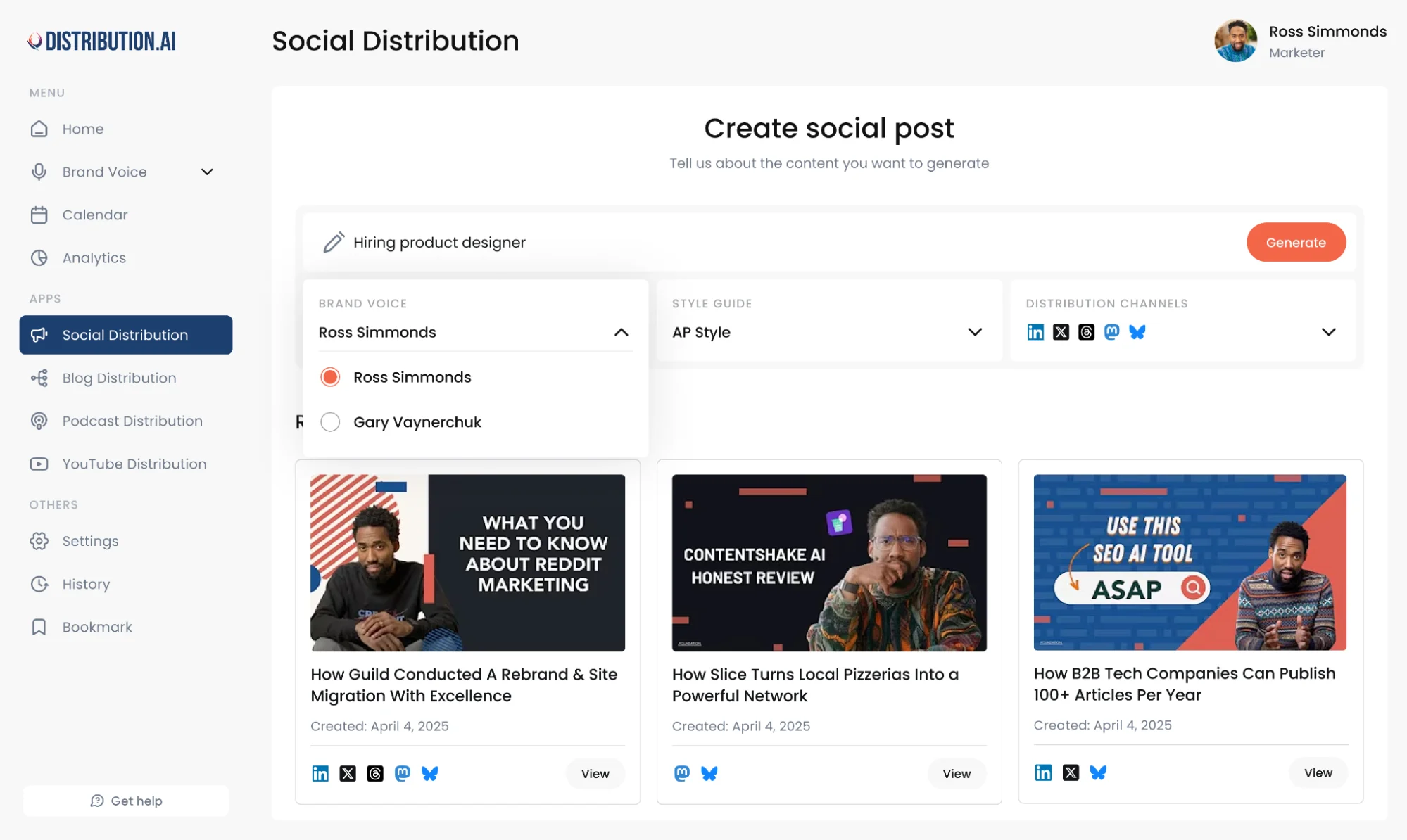
5. Hyper-Personalization
Generic content strategy is dead. Facebook’s AI crafts experiences so specific that two people side by side see completely different feeds.
This extends to ads, too.
Paid promotion and ad spend now require laser-focused target audience definitions. Only content users find genuinely valuable breaks through.
How Does Content Recommendation Work on Facebook?
Facebook’s recommendation engine offers brands a powerful way to reach new audiences without ad spend or paid promotion.
The Facebook algorithm personalizes recommendations for each user based on user behavior, search history, and past behavior to surface relevant content that matches each user’s preferences.
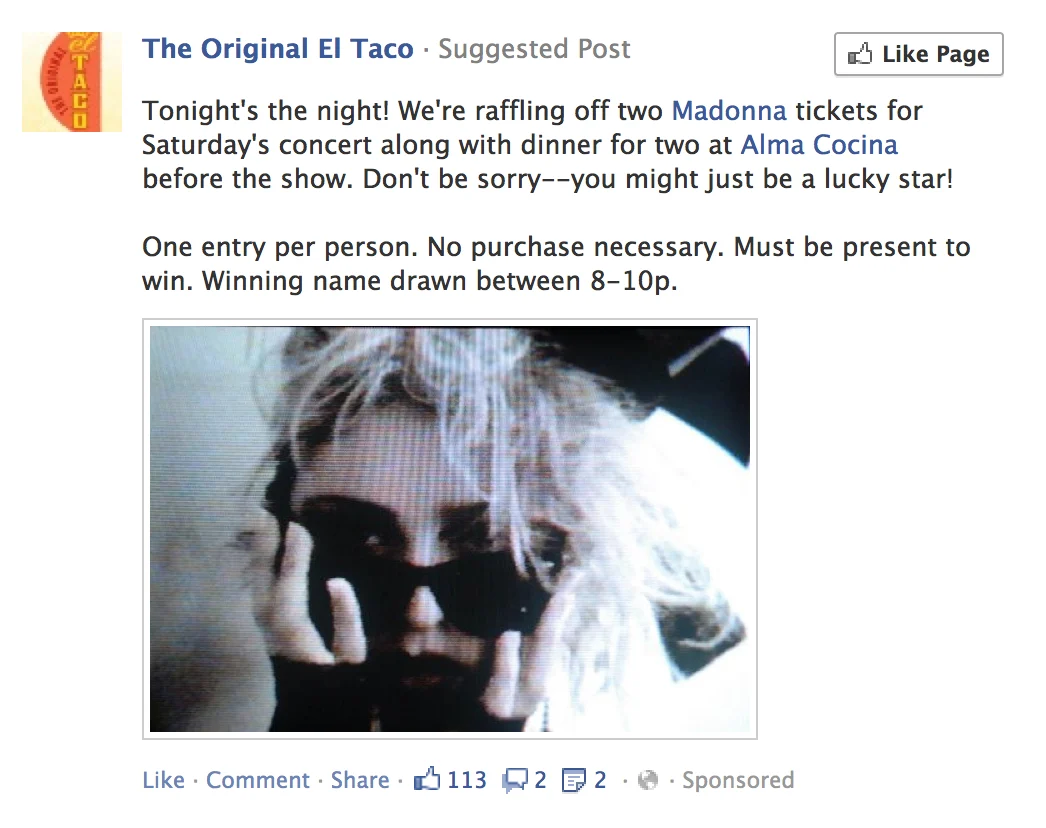
Meeting the Baseline: Community Standards
Before the Facebook algorithm recommends your content, you must comply with Facebook’s Community Standards.
These rules define what’s acceptable on the social media platform.
Content violating these standards gets removed, including:
- Violence and criminal activity
- Self-harm, suicide, or eating disorder promotion
- Child exploitation or harassment
- Spam and inauthentic behavior
- Fake news and misleading content
But clearing Community Standards isn’t enough.
Facebook maintains stricter Recommendation Guidelines that determine what gets amplified.
The Five Content Types That Block Recommendations
1. Safety-Compromising Content
Material discussing self-harm, suicide methods, eating disorders, or promoting regulated substances gets excluded from recommendations across all content formats, including Facebook posts and video content.
2. Low-Quality or Predatory Content
Posts promoting miracle cures, dubious supplements, or questionable financial schemes get filtered.
The Facebook algorithm ranks content based on trustworthiness, and predatory material tanks your relevance score.
3. User-Disliked Content Engagement bait tops this list.
Posts that beg for likes or use clickbait headlines are penalized.
The algorithm tracks which content types users hide, then suppresses similar posts. If posts people consistently skip resemble yours, your organic reach plummets.
4. False Information
Fake news, debunked claims, and misleading content verified as false by fact-checkers get blacklisted.
Once flagged, your ability to reach new audiences through organic content discovery is permanently damaged.
How to Maximize Your Content Recommendation Potential on Facebook
1. Prioritize quality over quantity.
The Facebook algorithm prioritizes content that provides genuine value.
Create content that addresses your target audience’s real needs, rather than chasing engagement tricks.
Define your brand personas before creating anything.
Each audience segment interacts differently with Facebook’s feed. What grabs a Gen Z buyer might not resonate with a B2B decision-maker.
When you create with these personas in mind, your posts naturally align with user behavior patterns the algorithm recognizes as relevant.
Tools like Distribution AI help tailor tone, format, and messaging for each persona so your content connects without losing efficiency.
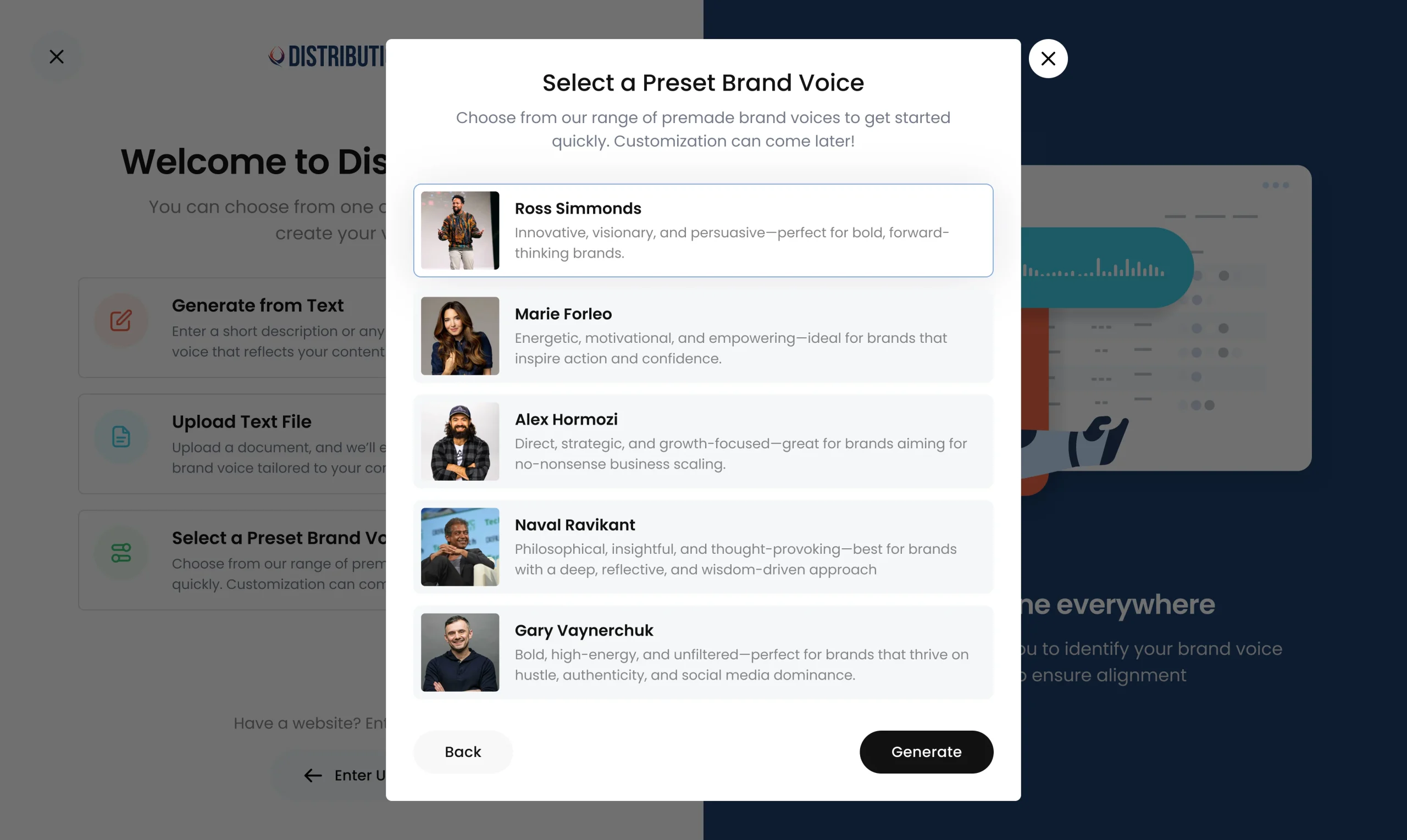
2. Leverage video formats.
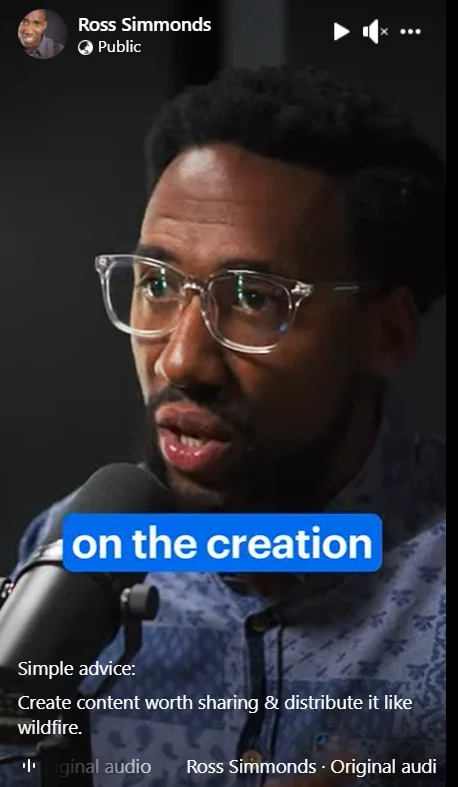
Facebook reels, engaging video content, and live videos outperform text-based posts in recommendation feeds.
The Facebook reels algorithm especially favors native vertical video.
3. Build credibility consistently.
The ranking factors reward Facebook pages with a strong history of high-quality content and positive user engagement. Your relevance score improves as the system confirms your content resonates.
4. Track performance religiously.
Use Facebook insights to identify which content the algorithm deems recommendation-worthy. Maintain a consistent posting schedule focused on valuable content over volume.
5. Strategically redistribute your content.
Don’t let great content die after one post.
Share top-performing organic posts in relevant Facebook groups, repurpose successful content into different content formats like Facebook reels or carousel posts, and cross-post valuable content at optimal times to reach different segments of Facebook users.
This extends your organic reach and maximizes how Facebook distributes content across the social network.
Understanding the Facebook Feed Algorithm
As we mentioned earlier, the Facebook algorithm works through four core stages:
1. Inventory
All available content from your connections’ Facebook pages, Facebook groups, friends, plus relevant ads and recommended content based on your activity.
Facebook emphasizes that the user’s feed “primarily comprises content shared by your connections.”
2. Signals
The Facebook algorithm analyzes hundreds of thousands of ranking signals, including who posted the content, when it was posted, its format, and the user’s interaction history.
These signals feed into how the Facebook algorithm ranks content.
3. Predictions
Using machine learning, the system crunches signal data to predict which content you’ll engage with.
The Facebook algorithm makes educated guesses about user behavior based on past behavior patterns.
4.Relevance
Each post receives a relevance score determining its feed position. Higher scores appear at the top of the user’s feed. Facebook predicts:
- Likelihood to click
- Time spent viewing the post
- Likelihood to like, comment, or share (meaningful interactions)
- Whether you’ll find this informative
- Whether it’s clickbait or engagement bait
- Whether it links to low-quality content
User Controls That Train the Algorithm
Facebook users can customize their feed through these actions that directly impact the ranking system:
- Manage Favorites: Prioritize content from specific people and Facebook pages to see their posts first. This tells the algorithm to increase the relevance score for these sources.
- See Newest First: Switch from algorithmic ranking to reverse chronological order, viewing content from followed accounts by recency rather than predicted relevance.
- Hide a Post: Removes the post and minimizes similar posts from appearing. This signals the algorithm to reduce the distribution of comparable content.
- Show More/Less: Temporarily adjusts the relevance score for specific content types, teaching the algorithm your preferences.
- Unfollow/Reconnect: Stop or resume seeing posts from people, Facebook pages, or Facebook groups without unfriending or leaving.
- Snooze: Temporarily pause posts from a source for 30 days without permanently unfollowing.
- Report Content: Flag spam, fake news, or misleading content to help Facebook identify and suppress low-quality content across the platform.
These user actions create powerful feedback loops.
When Facebook users consistently hide certain content types or engage more with specific formats, like video or Facebook Reels, the algorithm adapts the user’s feed accordingly.
For brands, this means your content strategy must align with both algorithmic preferences and genuine user engagement to maintain organic reach.
Understanding the Facebook Reels Algorithm
The Facebook reels algorithm uses the same four-stage system as the main Feed: inventory, signals, predictions, and relevance.
But it prioritizes different behaviors specific to short-form video.
What the Algorithm Actually Tracks?
Facebook monitors specific engagement patterns to rank Reels:
- How long viewers watch and whether they finish
- Clicks to expand videos from Feed previews
- Shares to WhatsApp and Messenger
- Sequential viewing behavior (binge-watching multiple Reels)
- Likes and shares
- Total time spent in the Reels tab after the first video
These signals come from your past behavior. The system learns which video content formats you prefer, which creators you engage with, and which topics hold your attention.
Creating Facebook Reels That Perform
1.Format Essentials
Stick to native vertical video without watermarks from other platforms.
Facebook actively suppresses content with TikTok logos, borders, or horizontal formats.
Use sharp, well-lit footage; blurry videos get buried.
2.Boost Engagement
Use Facebook’s built-in tools: text overlays, filters, effects, and the audio library.
Adding trending music helps discovery.
Content that entertains, starts trends, or joins existing ones gets amplified.
3.Quality Wins
Strong lighting, steady shots, and compelling storytelling keep viewers watching longer, the primary metric Facebook uses to rank content.
So what tanks your reach?
Recycled content with visible watermarks, poor quality, incorrect aspect ratios, or anything that looks repurposed from other platforms won’t be recommended.
This kills your organic reach, regardless of the content’s actual quality.
The algorithm rewards native, polished video that maximizes watch time.
The Facebook Stories Algorithm
Facebook Stories follow the same AI-powered ranking system as Feed and Reels, but content disappears after 24 hours.
How Stories Get Ranked
1.Gather & Filter
Facebook collects relevant content from the past 24 hours and removes any content that violates Community Standards.
2.Predict Value
The Facebook algorithm predicts which Stories you’ll find most valuable based on user behavior and removes the rest.
3.Rank by Engagement
Remaining Stories are ranked by the likelihood of user interaction. Facebook applies additional rules to ensure a diverse content mix.
Facebook users can shape their Stories experience:
- Report: Flag violations of Community Standards
- Mute: Stop seeing Stories from specific accounts
- Unfollow: Remove someone’s Stories entirely
- Share: Signal value by resharing to your Story or Messenger
- See Oldest First: View Stories chronologically before they expire
Creating Stories That Perform
1.Use Vertical Format
Shoot natively in vertical video for optimal viewing.
2.Leverage Templates
Facebook’s built-in templates simplify content creation for non-designers.
3.Add Clear CTAs
Every Story should encourage action.
More meaningful interactions signal to the algorithm that your content should be prioritized for those Facebook users, boosting your organic reach on the platform.
The Value of Employee Advocates in Your Facebook Strategy
Employee advocacy amplifies your reach beyond what brand pages can achieve alone. Posts shared by employees generate 8x more engagement than content posted directly from business accounts.
Why does it work?
The Facebook algorithm favors personal profiles over Facebook pages.
When employees share your content, it appears as a trusted recommendation rather than a branded post, which triggers stronger ranking signals and higher placement in the user’s feed.
The math is compelling: 100 employees with 400 connections each can reach 40,000 Facebook users through organic content alone.
Here is a quick implementation strategy:
1.Enable sharing
Encourage employees to distribute company content that aligns with your marketing strategy. Voluntary sharing outperforms forced participation.
2. Empower creation
Let employees create content reflecting their expertise. Employee-generated posts feel authentic, driving stronger, meaningful interactions.
3. Use platforms
Tools like Distribution AI that streamline sharing with pre-approved content and track which advocates drive the most user engagement.
4.Go cross-platform
Employee advocacy works beyond Facebook. On LinkedIn, employee-shared content reaches 561% further than the same post from a brand page.
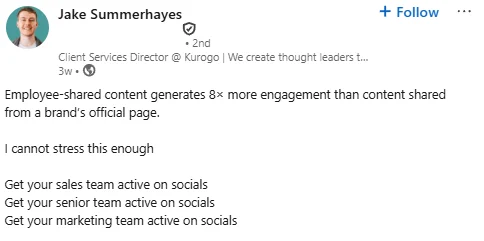
For brands facing declining organic reach, employee advocates offer cost-effective amplification that works with how the Facebook algorithm prioritizes content from real people over commercial sources.
9 Smart Tactics to Win the Facebook Algorithm
1. Prioritize Originality Over Repurposing
Original content gets 2.3x more organic reach than recycled posts.
The Facebook algorithm detects and rewards unique content while suppressing duplicate material across Facebook pages.
Create fresh posts tailored specifically for your target audience rather than cross-posting from other social media platforms.
2. Leverage Facebook’s Native Tools
Posts that use native features like Facebook Reels, polls, and live videos receive much more engagement than external links.
The Facebook algorithm prioritizes content created within the platform because it keeps Facebook users engaged longer.
Use built-in editing tools, music libraries, and interactive features.
3. Post When Your Audience is Active
The Facebook algorithm favors content that gets immediate interaction.
Analyze when your target audience is online and maintain a consistent posting schedule during these peak windows.
You can schedule your posts directly using Distribution AI to keep your content consistent, even when your team is offline.
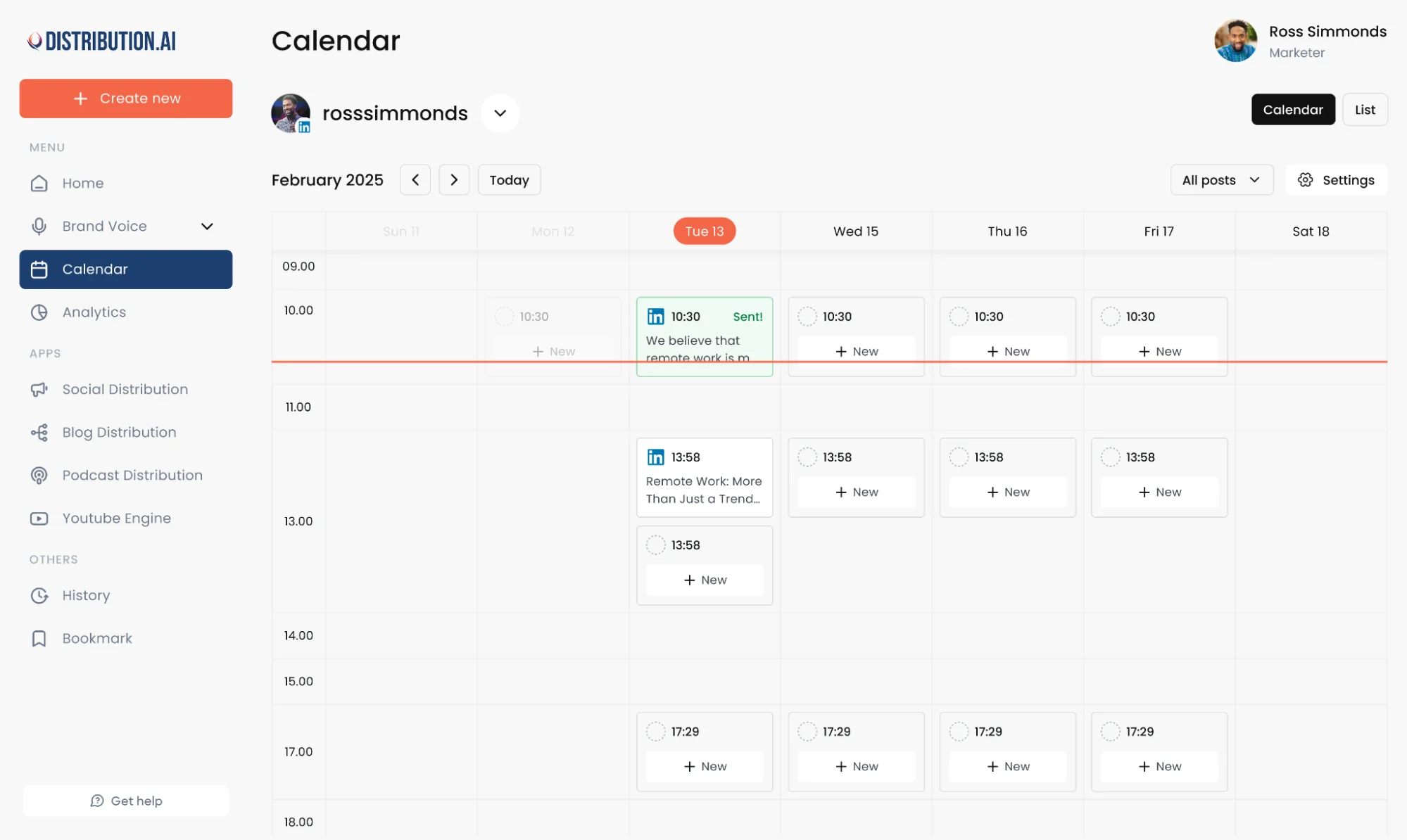
4. Create Content Your Audience Actually Values
Study your Facebook insights to identify which content formats resonate most.
The Facebook algorithm ranks content based on predicted value to each particular user, so understanding user behavior is critical.
5. Make Genuine Two-Way Conversations

The Facebook algorithm tracks response rates and the quality of user interactions.
Reply thoughtfully to comments, ask questions in your posts, and create content that naturally encourages discussion rather than passive consumption.
6. Avoid Algorithmic Manipulation Tactics
The Facebook algorithm actively penalizes misleading content, clickbait, and artificial interaction requests.
Focus on authentic engagement rather than tricks. Violations can permanently damage your relevance score and organic reach.
7. Diversify Your Content Mix
Mix Facebook reels, video content, text-based posts, photo carousels, and live videos.
The Facebook algorithm rewards diversity to keep users’ feeds fresh and prevent fatigue from similar posts.
8. Harness the Power of Multi-Image Posts
Multi-image carousels keep Facebook users engaged longer as they swipe through, sending positive signals to the ranking system.
Use albums to tell stories, showcase products, or share step-by-step processes.
9. Let Data Drive Your Strategy
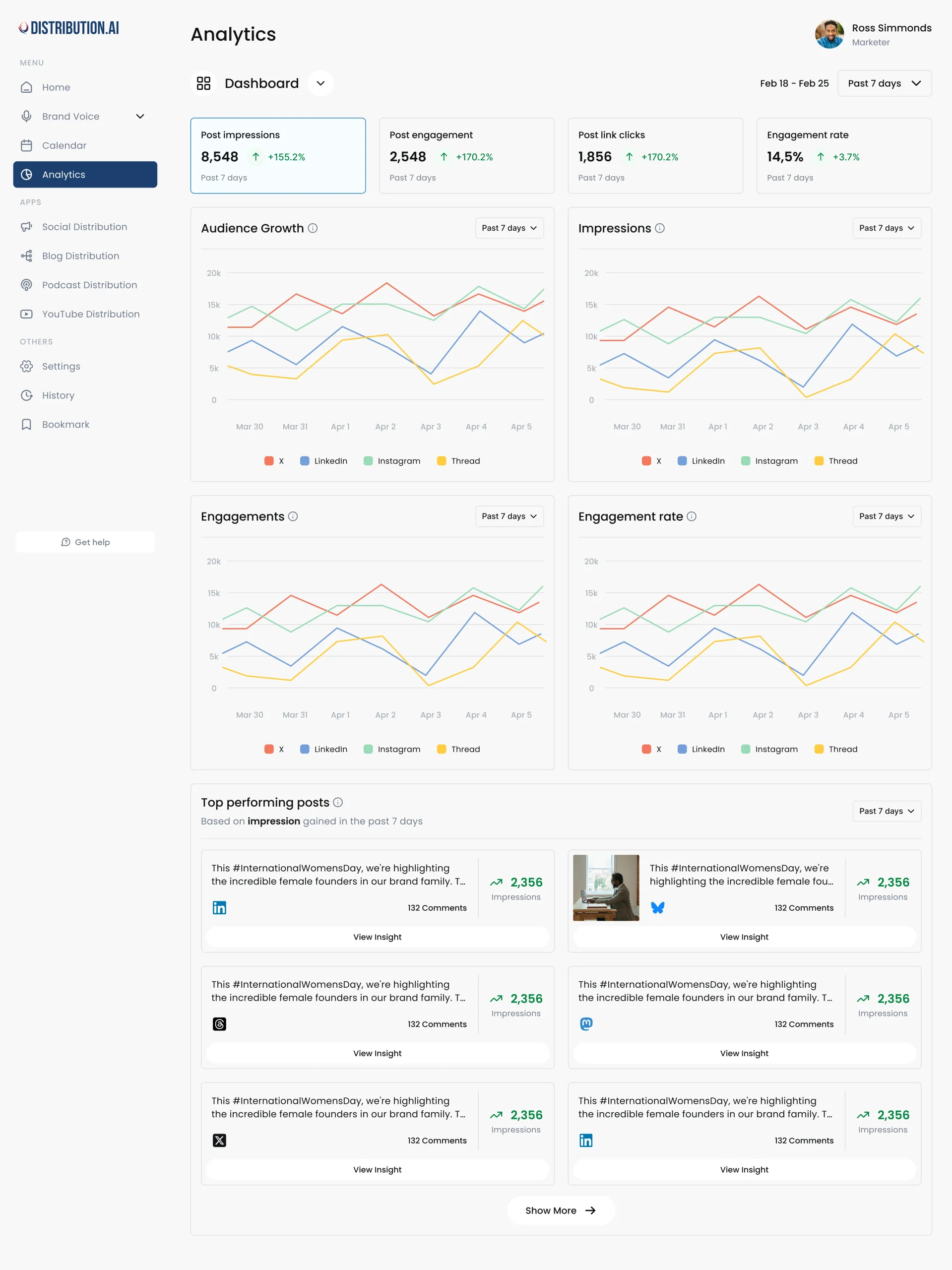
You can use detailed dashboards like Distribution AI’s native analytics to track which content drives the most engagement, when your audience interacts most, and which formats they prefer.
The Facebook algorithm is constantly evolving, so regular monitoring ensures your content strategy adapts accordingly.
The Facebook algorithm in 2025 is built to reward authentic, high-value content.
Brands that understand their audience, post consistently, and engage meaningfully will continue to earn visibility even as the rules evolve.
Stay focused on what matters most to your followers, track performance closely, and keep experimenting with new formats.
The brands that adapt fastest will always have the advantage.
See how Distribution AI helps your content stay visible.
Frequently Asked Questions
Promote, repurpose & distribute your content with AI
Start 15-Day Free Trial